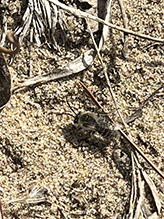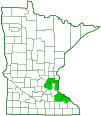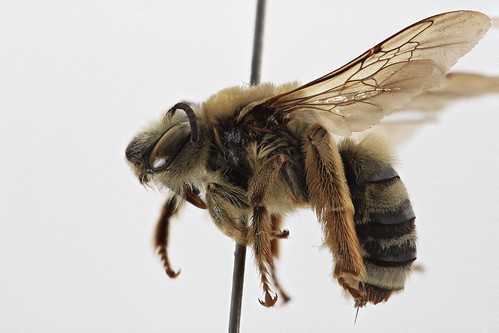hook-spurred longhorn
(Eucera hamata)
Conservation • Description • Habitat • Ecology • Distribution • Taxonomy
Conservation Status |
|
|||||||
| IUCN Red List | not listed |
|||||||
| NatureServe | NNR - Unranked SNR - Unranked |
|||||||
| Minnesota | not listed |
|||||||
Description |
||
Hook-spurred longhorn is a hairy, black, moderately large, long-horned bee. It occurs in the United States from New Hampshire and Florida west to North Dakota and Colorado. They are among the first bees to emerge in spring and are absent by the end of August. They feed on the pollen of plants mostly in the pea (Fabaceae) family but also from a handful of other families. They are rarely found on flowers in the aster (Asteraceae) family. They nest in the ground in sandy or clay soils. They are solitary but sometimes nest in aggregations. The female is ⅝″ (16 to 17 mm) in length. The head and body are densely covered with long hairs, giving it a furry appearance. The hairs on the head are entirely light brownish-yellow. The plate above the upper lip (clypeus) bulges outward strongly. It is not lobed. At its widest point each lateral margin touches the adjacent compound eye. The tongue (glossa) is long and slender. The finger-like sensory organs next to the tongue (labial palps) are long and flattened. The palps have four segments. The first two segments are much longer than the second two. The antennae have 12 segments, a long scape at the base, a short pedicel, and a whip-like section (flagellum) with 10 segments (flagellomeres). They are black above and brownish-black below. The first flagellomere is one and a half times as long as the second flagellomere. The body is robust and nearly all black. The thorax and abdomen are densely covered with relatively long and more or less erect hairs. On the thorax the hairs are entirely light brownish-yellow. The first abdominal segment has abundant, very long, pale brownish-yellow or whitish hairs at the base. Segments 2 and 3 have a narrow band of dark hairs at the base, followed by a wide band of white hairs, followed by a hairless black area at the rear. Segment 4 has black hairs with a band of white hairs at the rear. Segment 5 has black hairs at the base, brownish hairs in the middle, and dense white hairs on the sides. Segment 6 has brownish hairs on each side. The legs are black and are covered with light brownish-yellow hairs. On the middle and hind legs there is a spur at the tip of the fourth segment (tibia). The spur is abruptly curved backward or hooked at the tip. This is the feature that gives the species its common name. On the hind legs there is a feather-like (plumose) tuft of pollen-collecting hairs (scopa). The scopa is pale yellowish-brown. The last part of the leg (tarsus), corresponding to the foot, has five segments. The wings are glassy and translucent at the base becoming lightly cloudy at the tip. The veins are light brownish-gray to dark blackish-brown. There are three submarginal cells on the forewing. The second cell is shorter than the first and third cells. The third cell is much longer than wide. All cells on the wing are covered with scattered, minute, dark hairs, though these may not be visible without magnification. The small plates (tegulae) covering the wing bases are yellowish and transparent. The male is smaller, ½″ to 9⁄16″ (13.5 to 14.5 mm) in length. The antennae have 13 segments and are much longer. The upper part of the mouth (labrum) and clypeus are entirely yellow. The jaws (mandibles) are yellowish at the tip. |
||
Size |
||
Female: ⅝″ (16 to 17 mm) Male: ½″ to 9⁄16″ (13.5 to 14.5 mm) |
||
Similar Species |
||
Habitat |
||
|
||
Ecology |
||
Season |
||
April to August |
||
Behavior |
||
|
||
Life Cycle |
||
|
||
Larva Food |
||
|
||
Adult Food |
||
Pollen mostly from plants in pea (Fabaceae) family. |
||
Distribution |
||||
|
Sources |
|||
| 5/24/2022 | ||||
Occurrence |
||||
|
||||
Taxonomy |
|||
Order |
Hymenoptera (Ants, Bees, Wasps, and Sawflies) | ||
Suborder |
Apocrita (Narrow-waisted Wasps, Ants, and Bees) | ||
Infraorder |
Aculeata (Ants, Bees, and Stinging Wasps) | ||
Superfamily |
Apoidea (Bees and Apoid Wasps) | ||
| Epifamily | Anthophila (bees) | ||
Family |
Apidae (honey bees, bumble bees, and allies) | ||
Subfamily |
Apinae (honey, bumble, longhorn, orchid, and digger bees) | ||
Tribe |
Eucerini (long-horned bees) | ||
| Subtribe | Eucerina | ||
Genus |
Eucera | ||
| Subgenus | Synhalonia | ||
Synonyms |
|||
Synhalonia hamata Tetralonia hamata |
|||
Common Names |
|||
hooked longhorn bee hook-spurred longhorn hook-spurred longhorn bee |
|||
Glossary
Clypeus
On insects, a hardened plate on the face above the upper lip (labrum).
Flagellomere
A segment of the whip-like third section of an insect antenna (flagellum).
Labrum
The upper part of the mouth, sometimes considered the lower part of the face, corresponding to the upper lip, on an insect or crustacean.
Palp
Short for pedipalp. A segmented, finger-like process of an arthropod; one is attached to each maxilla and two are attached to the labium. They function as sense organs in spiders and insects, and as weapons in scorpions. Plural: palpi or palps.
Scopa
A brush-like tuft of hairs on the legs or underside of the abdomen of a bee used to collect pollen.
Tarsus
On insects, the last two to five subdivisions of the leg, attached to the tibia; the foot. On spiders, the last segment of the leg. Plural: tarsi.
Tegula
A small, hardened, plate, scale, or flap-like structure that overlaps the base of the forewing of insects in the orders Lepidoptera, Hymenoptera, Diptera, and Homoptera. Plural: tegulae.
Tibia
The fourth segment of an insect leg, after the femur and before the tarsus (foot). The fifth segment of a spider leg or palp. Plural: tibiae.
Visitor Photos |
|||||
Share your photo of this insect. |
|||||
| This button not working for you? Simply email us at info@MinnesotaSeasons.com. Attach one or more photos and, if you like, a caption. |
|||||
Nancy Falkum |
|||||
 |
|||||
MinnesotaSeasons.com Photos |
|||||
|
|||||

Visitor Videos |
|||
Share your video of this insect. |
|||
| This button not working for you? Simply email us at info@MinnesotaSeasons.com. Attach a video, a YouTube link, or a cloud storage link. |
|||
Other Videos |
|||

Created: 5/24/2022
Last Updated:




